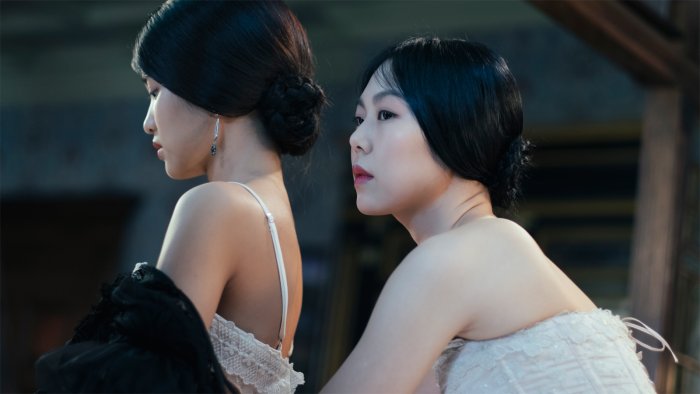The Handmaiden
[…] There are things to be learned and things to be seen, but the more you do, the more reality will shift and turn, and you might find yourself losing the firm ground beneath you – just don’t get dragged down into that cellar. Abandon all hope, ye who enter here, the snake might be proclaiming.
[…] «The Handmaiden» is a complex film, and its achronologial, matryoshka-like structure definitively demands multiple viewings, for it is also aesthetically overwhelming, causing one to lose grasp of its numerous interlinked themes of desire, betrayal, cultural and sexual identity, and the gaze.
Text: Dominic Schmid

The sculpture of a snake – or let’s say serpent in light of its biblical allusions – standing at the entrance to Uncle Kouzuki’s library, which is filled to the brink with erotic literature, should probably be considered a warning. With its placement and direct gaze, it warns the visitor against looking too closely, whether he/she is a houseguest invited to one of the frequently held stimulating recitation performances, or the viewer, for nothing is as it seems at first glance in Park Chan-wook’s amazing maze of a film. The mansion itself, classically Gothic in its outer appearance, contains architectural designs from English and Japanese traditions, both appearing equally out of place in its 1920s Korean setting. Then there is its cellar – its subconscious, so to speak – which promises horrors of yet another kind of perversity, horrors which well surpass the initial discomfort one might feel regarding just the weird mix of cultural appropriation and subjugation (which mirrors those of its owner) promised at the surface. The mansion can be viewed as a more than an apt metaphor for The Handmaiden itself. There are things to be learned and things to be seen, but the more you do, the more reality will shift and turn, and you might find yourself losing the firm ground beneath you – just don’t get dragged down into that cellar. Abandon all hope, ye who enter here, the snake might be proclaiming.
The plot may feel classic at first, and indeed it is adapted from Sarah Water’s 2004 revisionist-lesbian novel Fingersmith, set in Victorian Era-England, transposed by Park to Japanese-occupied Korea. Young pickpocket Sook-Hee is hired by the fake Count Fujiwara to help him seduce rich heiress Hideko, who lives with her Japanophile uncle in the mansion. Sook-Hee is instantly attracted not only to Hideko’s jewelry, which she is promised to be allowed to keep for herself after Fujiwara succeeds in seducing and marrying the heiress and committing her to the lunatic asylum, but also to Hideko herself. She quickly learns that appearances and alliances are a lot more fluid than she had initially assumed. Like Sook-Hee, the viewer is thrust into this scenario without any knowledge of anyone’s true intentions, at first seeing the world through the pickpocket’s eyes, which seem to operate with heightened sensuality concerning objects and female bodies. This changes when the narrative doubles back and recounts the same events from another character’s perspective, sometimes altering the meaning of events that have already been witnessed by 180 degrees. This is by no means a gimmick, but corresponds beautifully to a world where hidden agendas, both political and private, and actions executed with limited knowledge abound, and where it matters to the utmost who is looking at what or whom, and how.
It’s Hitchcock with a feminist twist, with Park, who has lengthily spoken of the great influence the master of suspense’s work had on his own, moving his camera and his actors around with complete control over atmosphere and affect, but it’s also Bresson’s highly sensual depictions of hands, body parts, objects and their spacial and haptic relations, viewed through the knowing eyes of the pickpocket. The Handmaiden is at the same time cold and sensual, it’s plot moving forward like a machine, nevertheless finding time for lengthy and highly erotic sequences, such as when Sook-hee, with a sharp metal cap over her index finger, is filing Hideko’s teeth, the latter lying naked in a free-standing bathtub. Or in the way the protagonists incorporate (and subversively appropriate) more and less likely scenarios from Uncle Kouzuki’s perverse books into their own sexual routines. And, as a clear cinematic novelty, Park even offers us the point-of-view of a vagina during the pivotal sex-scene, a scene which takes the controversial sex act from Kechiches Blue is the Warmest Color and flips it on its head, insofar as it’s not primarily about the act, but about the fact that we are watching it. The least one can say is that it, and the whole film in way, profoundly complicates the (male) gaze – the character’s, the viewer’s and even that of the film’s director himself.
Those familiar with Park’s body of work, especially his “Vengeance-Trilogy” (Sympathy for Mr. Vengeance, Oldboy, Sympathy for Lady Vengeance), might vividly recall their penchant for a certain kind of ultra-violence coupled with hardcore moral dilemmas and other psychological horrors, will be pleased to hear (or not, depending on taste), that The Handmaiden is in a way an easier watch than the aforementioned films, more similar to Stoker, his last film and so far his only US-production. But in a way, the violence here cuts deeper, because it operates not on the surface or in isolated moments (with a few notable exceptions), but inwards, targeting the mind over long periods of time. The cherry blossom tree outside the mansion is beautiful, but the pull that its branches manage to exert over the suicidally-inclined is even stronger.
The Handmaiden is a complex film, and its achronologial, matryoshka-like structure definitively demands multiple viewings, for it is also aesthetically overwhelming, causing one to lose grasp of its numerous interlinked themes of desire, betrayal, cultural and sexual identity, and the gaze. It is also unabashedly erotic, serious but also kinky and perhaps even funny at the same time, and manages to produce a number of unforgettable images – unforgettable precisely because they are never passive, but manage to look back, directly into the viewer’s confusedly aroused heart. It is fitting that by the end of the film, the snake with its puny warning will have been broken into splinters.
This article contains a third-party video. If you would like to watch the video, please adjust your settings.



